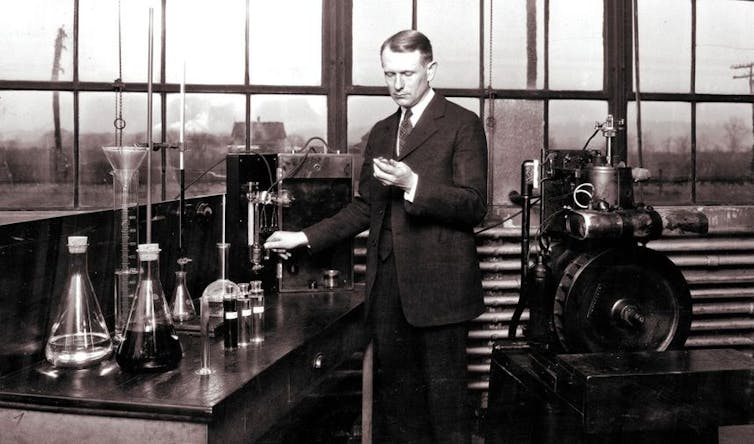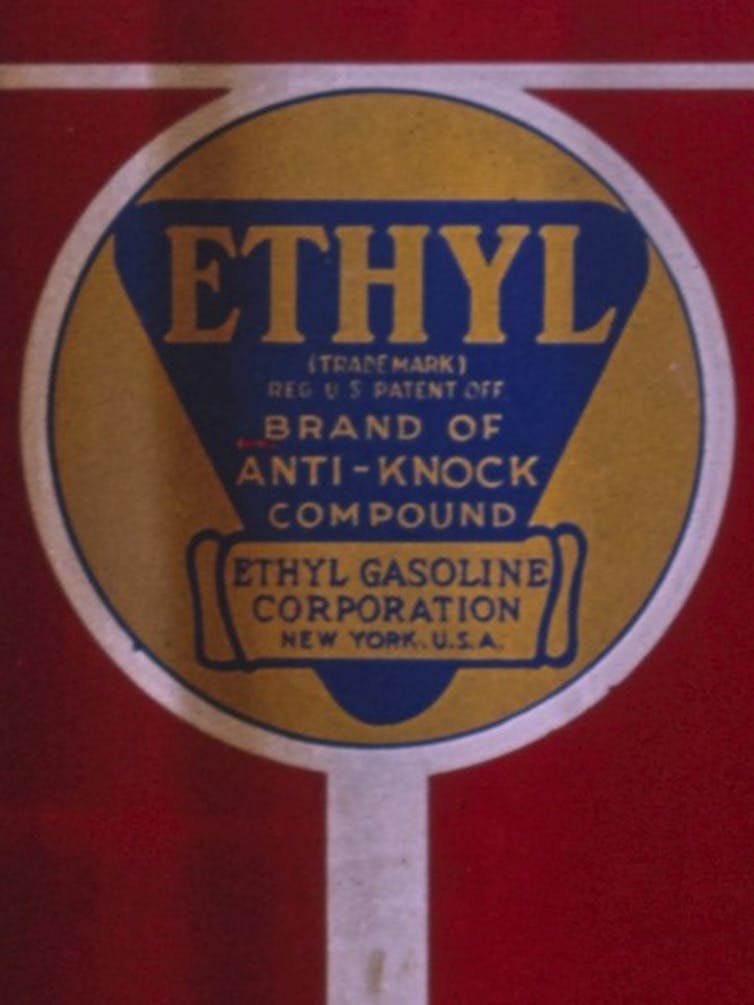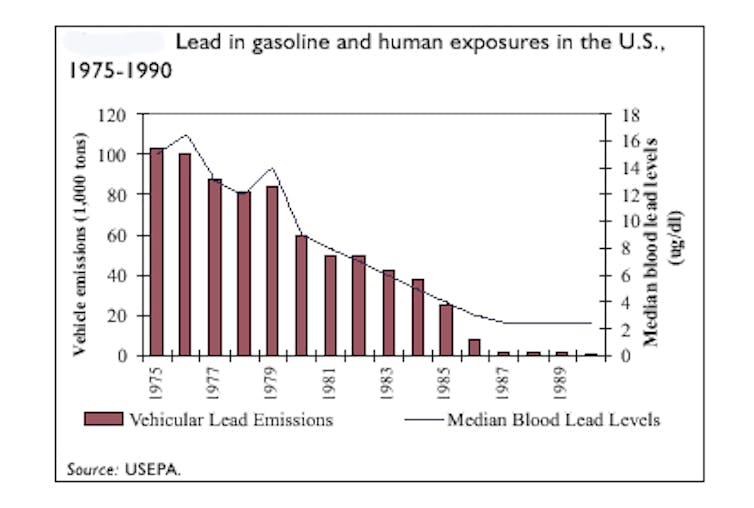
Experts in autocracies have pointed out that it is, unfortunately, easy to slip into normalizing the tyrant, hence it is important to hang on to outrage. These incidents which seem to call for the efforts of the Greek Furies (Erinyes) to come and deal with them will, I hope, help with that. As a reminder, though no one really knows how many there were supposed to be, the three names we have are Alecto, Megaera, and Tisiphone. These roughly translate as “unceasing,” “grudging,” and “vengeful destruction.”
In 1929, “Ellery Queen” began “his”* mystery-novel-writing career with “The Roman Hat Mystery,” just eight years after tetrsethyl lead started to be used in fuel for automobiles. The weapon his villain used to kill his victims in this book was tetraethyl lead. The deaths were quite gruesome. If “Queen” expected the novel to draw people’s attention to the dangers of using the stuff in gasoline and having it come out of the exhaust, it didn’t work. Ethanol existed then, but could not be patented, whereas tetraethyl lead could. It was not until the 1970’s that “Unleaded” gas appeared on the market, and “regular” was available alongside it for quite a while. I don’t currently have a source for this, but I remember reading that studies sone around this time and a bit later showed a direct correlation between the amount of ethyl gas used in an area and the amount of violent crime taking place in the same area. Big corporations making big money simply do not have the best interests of their customers in mind. But we are partly to blame for not forcing them to.
================================================================
A century of tragedy: How the car and gas industry knew about the health risks of leaded fuel but sold it for 100 years anyway

Per Magnus Persson via Getty Images
Bill Kovarik, Radford University
On the frosty morning of Dec. 9, 1921, in Dayton, Ohio, researchers at a General Motors lab poured a new fuel blend into one of their test engines. Immediately, the engine began running more quietly and putting out more power.
The new fuel was tetraethyl lead. With vast profits in sight – and very few public health regulations at the time – General Motors Co. rushed gasoline diluted with tetraethyl lead to market despite the known health risks of lead. They named it “Ethyl” gas.
It has been 100 years since that pivotal day in the development of leaded gasoline. As a historian of media and the environment, I see this anniversary as a time to reflect on the role of public health advocates and environmental journalists in preventing profit-driven tragedy.

Courtesy of General Motors Institute
Lead and death
By the early 1920s, the hazards of lead were well known – even Charles Dickens and Benjamin Franklin had written about the dangers of lead poisoning.
When GM began selling leaded gasoline, public health experts questioned its decision. One called lead a serious menace to public health, and another called concentrated tetraethyl lead a “malicious and creeping” poison.
General Motors and Standard Oil waved the warnings aside until disaster struck in October 1924. Two dozen workers at a refinery in Bayway, New Jersey, came down with severe lead poisoning from a poorly designed GM process. At first they became disoriented, then burst into insane fury and collapsed into hysterical laughter. Many had to be wrestled into straitjackets. Six died, and the rest were hospitalized. Around the same time, 11 more workers died and several dozen more were disabled at similar GM and DuPont plants across the U.S.

New York Evening Journal via The Library of Congress
Fighting the media
The auto and gas industries’ attitude toward the media was hostile from the beginning. At Standard Oil’s first press conference about the 1924 Ethyl disaster, a spokesman claimed he had no idea what had happened while advising the media that “Nothing ought to be said about this matter in the public interest.”
More facts emerged in the months after the event, and by the spring of 1925, in-depth newspaper coverage started to appear, framing the issue as public health versus industrial progress. A New York World article asked Yale University gas warfare expert Yandell Henderson and GM’s tetraethyl lead researcher Thomas Midgley whether leaded gasoline would poison people. Midgley joked about public health concerns and falsely insisted that leaded gasoline was the only way to raise fuel power. To demonstrate the negative impacts of leaded fuel, Henderson estimated that 30 tons of lead would fall in a dusty rain on New York’s Fifth Avenue every year.
Industry officials were outraged over the coverage. A GM public relations history from 1948 called the New York World’s coverage “a campaign of publicity against the public sale of gasoline containing the company’s antiknock compound.” GM also claimed that the media labeled leaded gas “loony gas” when, in fact, it was the workers themselves who named it as such.

John Margolies/Library of Congress
Attempts at regulation
In May 1925, the U.S. Public Health Service asked GM, Standard Oil and public health scientists to attend an open hearing on leaded gasoline in Washington. The issue, according to GM and Standard, involved refinery safety, not public health. Frank Howard of Standard Oil argued that tetraethyl lead was diluted at over 1,000 to 1 in gasoline and therefore posed no risk to the average person.
Public health scientists challenged the need for leaded gasoline. Alice Hamilton, a physician at Harvard, said, “There are thousands of things better than lead to put in gasoline.” And she was right. There were plenty of well-known alternatives at the time, and some were even patented by GM. But no one in the press knew how to find that information, and the Public Health Service, under pressure from the auto and oil industries, canceled a second day of public hearings that would have discussed safer gasoline additives like ethanol, iron carbonyl and catalytic reforming.
By 1926, the Public Health Service announced that they had “no good reason” to prohibit leaded gasoline, even though internal memos complained that their research was “half baked.”

U.S. EPA
The rise and fall of leaded gasoline
Leaded gasoline went on to dominate fuel markets worldwide. Researchers have estimated that decades of burning leaded gasoline caused millions of premature deaths, enormous declines in IQ levels and many other associated social problems.
In the 1960s and 1970s, the public health case against leaded gasoline reemerged. A California Institute of Technology geochemist, Clair Cameron Patterson, was finding it difficult to measure lead isotopes in his laboratory because lead from gasoline was everywhere and his samples were constantly being contaminated. Patterson created the first “clean room” to carry on his isotope work, but he also published a 1965 paper, “Contaminated and Natural Lead Environments of Man,” and said that “the average resident of the U.S. is being subjected to severe chronic lead insult.”
In parallel, by the 1970s, the U.S. Environmental Protection Agency decided that leaded gasoline had to be phased out eventually because it clogged catalytic converters on cars and led to more air pollution. Leaded gasoline manufacturers objected, but the objections were overruled by an appeals court.
The public health concerns continued to build in the 1970s and 1980s when University of Pittsburgh pediatrician Herbert Needleman ran studies linking high levels of lead in children with low IQ and other developmental problems. Both Patterson and Needleman faced strong partisan attacks from the lead industry, which claimed that their research was fraudulent.
Both were eventually vindicated when, in 1996, the U.S. officially banned the sale of leaded gasoline for public health reasons. Europe was next in the 2000s, followed by developing nations after that. In August 2021, the last country in the world to sell leaded gas, Algeria, banned it.
A century of leaded gasoline has taken millions of lives and to this day leaves the soil in many cities from New Orleans to London toxic.
The leaded gasoline story provides a practical example of how industry’s profit-driven decisions – when unsuccessfully challenged and regulated – can cause serious and long-term harm. It takes individual public health leaders and strong media coverage of health and environmental issues to counter these risks.
[You’re smart and curious about the world. So are The Conversation’s authors and editors. You can read us daily by subscribing to our newsletter.]![]()
Bill Kovarik, Professor of Communication, Radford University
This article is republished from The Conversation under a Creative Commons license. Read the original article.
================================================================
Alecto, Megaera, and Tisiphone, as a race, we humans are not terribly good at doing what is best for us. Up until the 1920’s, for instance, arsenic was still used in skin lotions. And before that it was white lead (lead carbonate), which still shows up in some paints and some ceramics. People did not want to give them up. Women did not want to give their cosmetics up. I’m not old enought o remember the pushback on arsenic or white lead, but I am definitely old enough to remember the pushback on unleaded gas. If people are so terrified of change that they become violently opposed to giving up poisons, I guess we shouldn’t be surprised at the lengths they will go to in order not to take a vaccine. Well, give us long enough and we will make ourselves extinct – and maybe more sensible creatures will evolve to take our place.
The Furies and I will be back.
*”Ellery Queen” was actually two dudes, Frederic Dannay and Manfred B. Lee – hence the two cross strokes in the “Q” on the book titles, at least the early ones. There’s no unicode for it so I can’t use it here.)
4 Responses to “Everyday Erinyes #296”
Sorry, the comment form is closed at this time.

Thanks Joanne.
I was sooooooo thankful when CA led the ban, and why we still have different gasoline and prices than the rest of the country. Soil along So CA’s residental areas lining their freeways remains at toxic levels. At the beginning of this century there was pressure on health professional to think children’s lead risk was limited to older lead-based paint that has been banned in CA for decades (never mind all those who bought theirs in NV).
In the 1990s some criminal justice researchers were doing HOD analyses (lead in hair clippings) for lead-violence associations. CA bans biomedical research on inmates so no local studies.
I have a pretty complete EQ collection and can well believe they had that intent given some of the elements in other works with similar intent, impacts.
Violence is also a characteristic, like drug abuse, associated with the aging out of processes that align with completed brain development, especially the portions related to impulse controls, around age 25. The end of leaded gas in CA did have a study completed taking age into account and violent crime rates (way down this century all over the country with CA’s trend starting sooner).
It isn’t only on climate change that such corporations should not have such influence on public policies.
If you don’t have “nd on the Eighth Day” I suggest looking it up. It’s totally unlike everythig else they ever wrote, and yet some how it encapsulates everything they ever wrote.
Thanks Joanne! –not sure whether I do (the hardbacks are one bookcase, paperbacks another in the room filled with boxes, etc. for regrout, sealing of tile due to happen when Covid shutdown hit). If I find it is a duplicate, I can gift it to mystery fan family member (we do it to one another).
Very well written.
A lot of this information was new to me, but not a surprise. We know from history that corporations will do anything to further their monetary goals, including killing people. As we enter into new energy sources now is not the time to ease regulations. In fact, just the opposite should happen. We already know some of the problems these new technologies bring and no technology will be problem free.